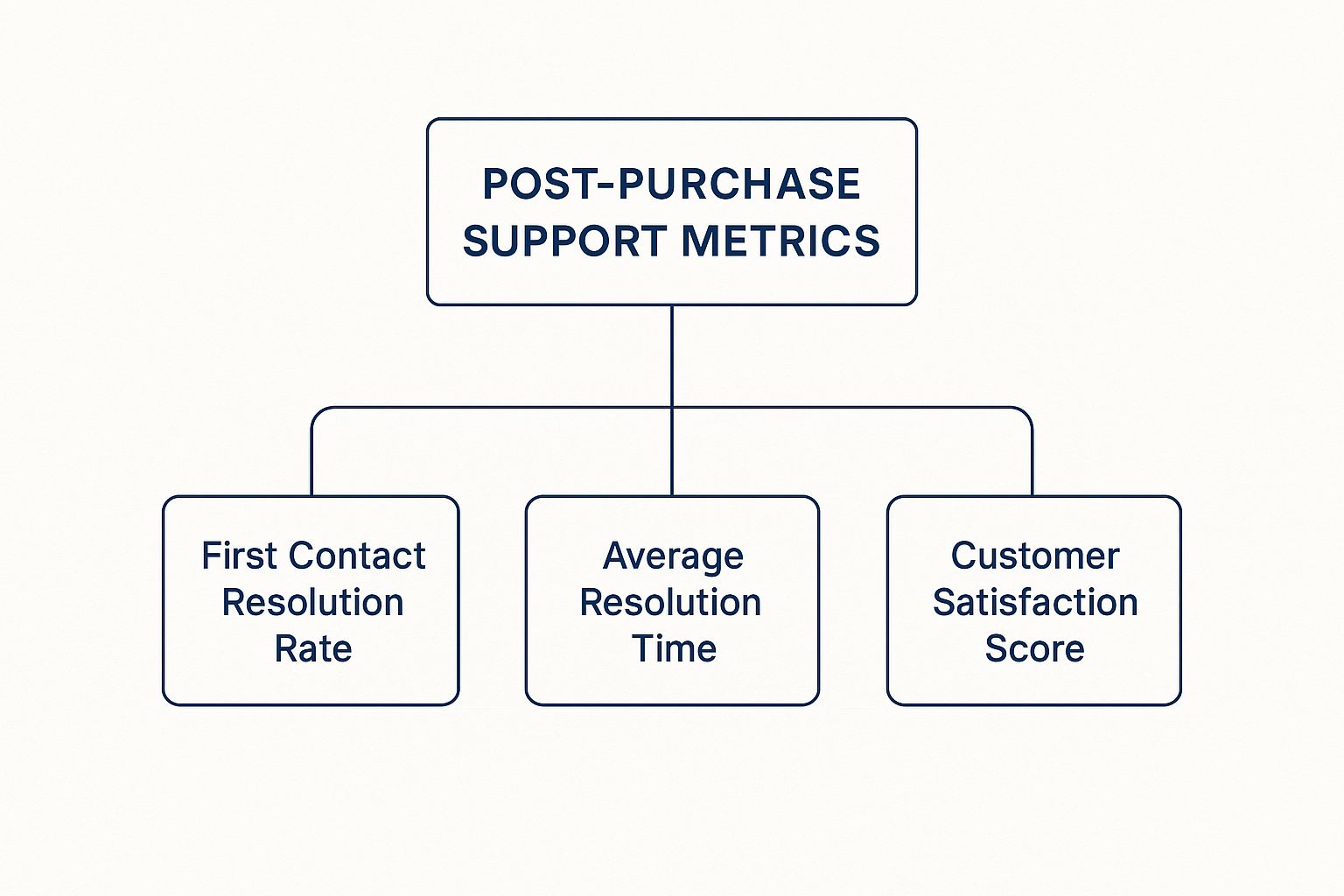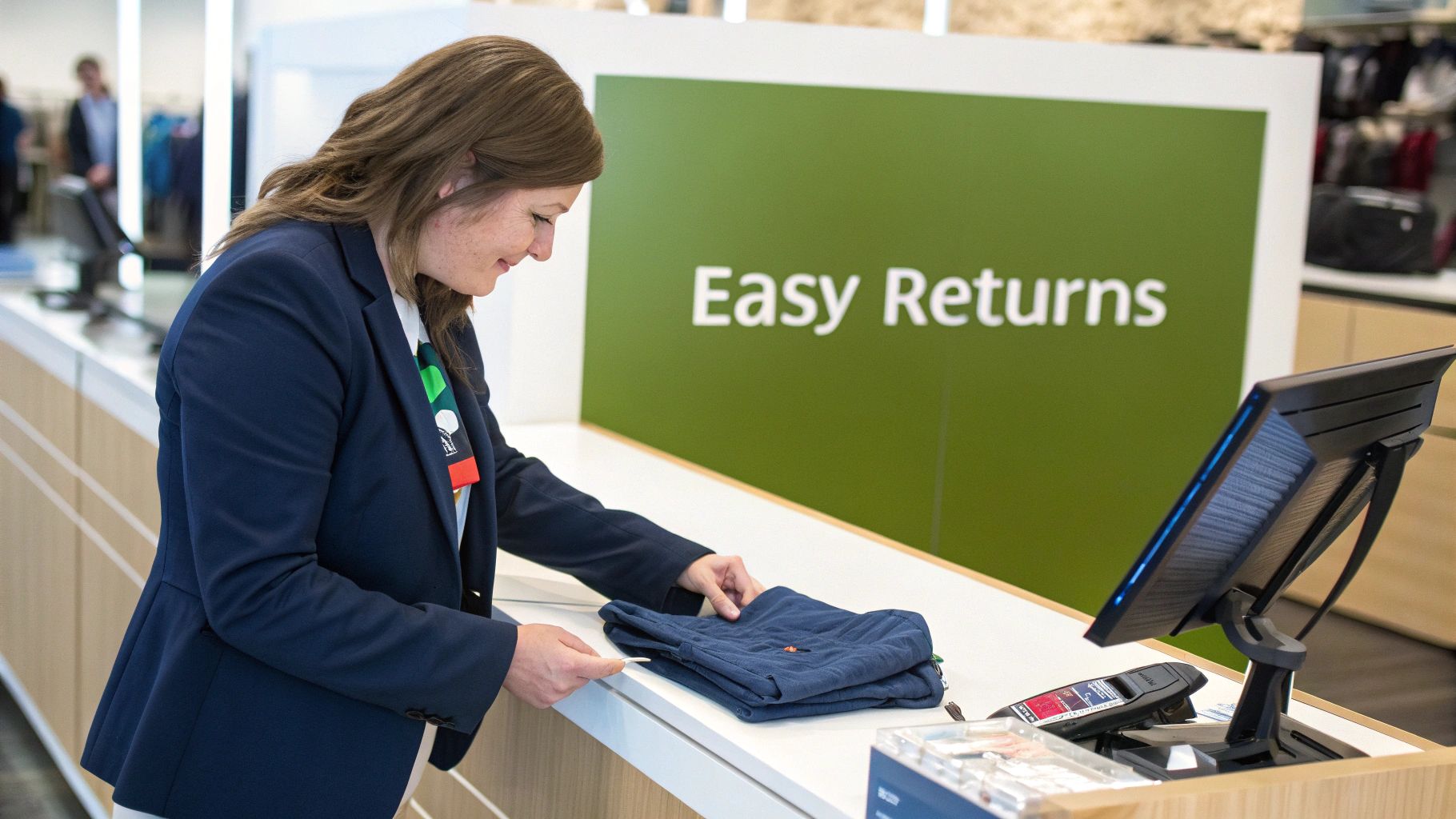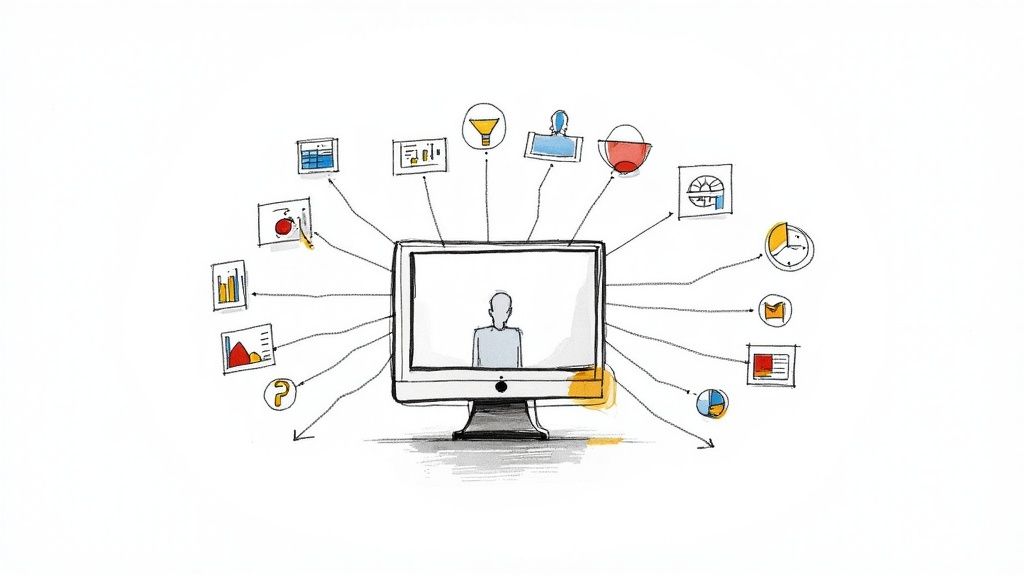Mastering the Post-Purchase Customer Experience: A Complete Guide
What exactly is the post-purchase customer experience? It’s every single touchpoint a customer has with your brand after they hit the 'buy' button. This isn't the end of the transaction; it's the very beginning of the relationship. It covers everything from the moment the confirmation email lands in their inbox to the unboxing and their first support question. A great post-purchase experience is critical for turning a one-time buyer into a lifelong advocate for your brand.
Why Your Business Really Begins After the Sale

Many businesses pour a ton of money and effort into acquiring customers, only to treat the final sale as the finish line. That's a huge mistake. The truth is, the moments right after a purchase are where your brand's promises are put to the test and where real, lasting loyalty is built.
Think about it like checking into a five-star hotel. Sure, the booking process was probably easy, but the real experience starts once you have the key. It's the impeccable service, the little details in the room, and the seamless checkout. That same idea holds true for any online business, whether you're selling shoes or software. This is your moment to turn a first-time buyer into a fan for life.
The Foundation of Customer Loyalty
A solid post-purchase experience is the bedrock of customer retention. It takes a simple transaction and turns it into a memorable experience, making customers feel seen, appreciated, and confident they made the right choice. The numbers don't lie. A staggering 89% of customers are more likely to buy again after a positive post-purchase experience.
This journey is made up of a few key moments, and each one is an opportunity to either impress or let them down:
- Order Confirmation: That first message they get after paying. Is it just a bland receipt, or is it a warm, reassuring welcome from your brand?
- Shipping and Tracking: Are you proactively sending updates that keep them in the loop and reduce that "where's my stuff?" anxiety?
- Unboxing or Onboarding: This is their first real-life interaction with what they bought. Is it exciting? Is it easy?
- Customer Support: When something goes wrong, how simple is it for them to get help?
- Follow-up Communication: Are you checking in after delivery, asking for feedback, and sending relevant offers?
Gathering Actionable Feedback
You can't improve what you don't measure. To make this journey better, you have to see it through your customers' eyes and figure out what’s clicking and what’s falling flat. A great way to get inside their heads and find those improvement spots is by leveraging post-purchase surveys.
A customer's perception is your reality. If they feel ignored after buying, the quality of your product becomes irrelevant. The post-purchase experience is where you prove you care about their success, not just their money.
When you nail these interactions, you do more than just stamp out buyer's remorse. You build genuine trust and create a powerful cycle of repeat business and free word-of-mouth marketing. In the next sections, we'll dig into where brands typically drop the ball and how you can build a strategy that truly wins customers over.
Where Most Brands Get the Post-Purchase Journey Wrong

Have you ever felt like a brand completely forgot about you the moment your payment was processed? It’s a surprisingly common feeling. That crucial journey from clicking "buy" to actually loving your new product is a minefield, and a lot of companies stumble right into it, leaving customers with a serious case of buyer's remorse.
The problem is that most brands are obsessed with getting new customers, not keeping the ones they have. They pour all their energy and budget into acquisition, treating the sale as the finish line. In reality, it’s the starting gun for the post-purchase customer experience. This creates a huge gap between what customers expect and the radio silence they get.
This isn't just a small oversight—it's a massive issue. Recent data shows that a staggering 56% of customers feel let down after they buy something. Even more damning, only 17% feel like companies actually care about them once the transaction is done. You can dig into these post-purchase satisfaction findings on lateshipment.com to see just how widespread the problem is.
The Transactional Mindset Trap
At its heart, this is a problem of perspective. Too many businesses are stuck in a transactional mindset, viewing the customer relationship as a simple quid pro quo: money for a product. As soon as the cash is in the bank, they're on to the next hunt, leaving their most recent buyer in a communication black hole.
This completely ignores the human side of the purchase. A customer just put their trust—and their money—in your hands. What they crave now is reassurance, clarity, and the feeling that they made the right choice. Instead, they’re often met with silence or, even worse, a maze of frustrating next steps.
Buyer's remorse isn't just a random feeling. It's a direct result of post-sale neglect. When communication dries up and support is nowhere to be found, customers naturally start to second-guess their purchase.
Common Failure Points That Destroy Trust
A few key missteps pop up again and again, consistently torpedoing the customer experience. These mistakes are so common that people almost expect them, which gives you a golden opportunity to stand out just by getting the basics right.
Here are the usual suspects:
- Vague and Unhelpful Shipping Information: Just tossing a tracking number from a third-party carrier over the wall isn't good enough. Customers are left to decode confusing shipping jargon on another website, which turns excitement into anxiety.
- Complicated and Opaque Return Policies: Nothing kills a customer relationship faster than a difficult return. Hidden fees, convoluted instructions, and painfully slow refunds make people feel tricked and trapped. They won’t be coming back.
- Robotic and Impersonal Communication: Generic, unbranded emails that sound like they were written by a robot do zero to build a connection. This lack of a human touch just confirms the suspicion that they're nothing more than an order number.
- Reactive, Not Proactive, Support: Forcing customers to chase you down when something goes wrong is a rookie mistake. The best brands anticipate problems—like a shipping delay—and get out in front of them. It turns a potential disaster into a moment that actually builds trust.
Every one of these blunders chips away at the goodwill you worked so hard to earn. By understanding these common mistakes, you can start building better customer communication strategies that not only prevent buyer's remorse but actively create loyal fans. The following sections will show you exactly how to build a winning strategy that tackles these very issues.
The Four Pillars of a Winning Post-Purchase Strategy
A truly great post-purchase customer experience doesn't just happen. It’s built, piece by piece, on a solid foundation. While the specifics can change from one business to another, any successful strategy is going to stand on four core pillars: Proactive Communication, Effortless Support, Smart Personalization, and Actionable Feedback.
Think of them like the legs on a table. If one is weak or missing, the whole thing feels wobbly and unreliable. But when all four are strong, you’ve created a stable, dependable platform for building real customer loyalty.
Pillar 1: Proactive Communication
The silence after a customer clicks "buy" can feel like an eternity. Proactive communication is all about filling that void with reassurance and value, getting ahead of a customer's worries before they even begin.
Don't just send a generic tracking number and cross your fingers. Take control of the delivery story. A branded tracking page with clear, real-time updates not only keeps customers informed but also reinforces your brand. Simple notifications for key milestones—order packed, item shipped, out for delivery—turn moments of anxiety into positive touchpoints.
Pillar 2: Effortless Support
When something goes wrong, the last thing your customer wants is a maze. Making support effortless means they can get help right away, whether that’s through a self-service tool or by talking to a real person.
This means being available on the channels your customers already use, like live chat, email, or even social media. A well-stocked knowledge base or a detailed FAQ section can solve common problems on the spot, which takes the pressure off both the customer and your support team.
The image below highlights a few key metrics for keeping track of your support effectiveness.

As you can see, great support isn't just about one thing. It's a balance of speed (Average Resolution Time), efficiency (First Contact Resolution), and how the customer feels about it all (CSAT). The goal isn't just to close a ticket, but to do it in a way that makes the customer feel heard and respected.
Pillar 3: Smart Personalization
In the post-purchase world, personalization is so much more than just dropping a first name into an email template. It's about using what you know about a customer’s purchase to give them content and offers that are genuinely helpful. If someone just bought a top-of-the-line camera, they don’t want to see an ad for a basic point-and-shoot.
What they would appreciate is a guide on "5 Tips for Mastering Your New Camera" or maybe a special discount on a compatible lens. That’s smart personalization. It shows you understand them and want them to get the most out of what they bought from you.
True personalization isn't just about selling more; it's about helping more. By anticipating a customer's next need, you prove you're a partner in their journey, not just a vendor.
To do this well, you need to let data guide your strategy. Here are a few practical ways to get started:
- Product Recommendations: Look at their purchase history and suggest things that actually make sense. Think cleaning supplies for new shoes or a protective case for a new phone.
- Targeted Content: Send tutorials, setup guides, or care instructions that are specific to the exact product they bought. This adds real value and helps them feel successful.
- Segmented Offers: Group customers based on their behavior—first-timers, loyal regulars, big spenders—and send them exclusive offers that feel special. A 10% discount might be perfect for encouraging a second purchase from a new customer, while a loyal fan would love getting early access to a new product line.
Pillar 4: Actionable Feedback
The final pillar is all about closing the loop. You can't fix what you don't know is broken, and the only way to improve the post-purchase customer experience is to ask people how it’s going.
This is more than just collecting star ratings. Use post-purchase surveys to dig into the details: How was the delivery? The packaging? The product itself? When you get negative feedback, don't treat it like a complaint. Treat it like a free consultation from someone who is telling you exactly what you need to fix.
Let's pull these four pillars together into a quick summary.
Four Pillars of Post-Purchase Experience
This table breaks down the core components of a strong post-purchase strategy, highlighting what you're trying to achieve with each pillar and how to get it done.
By building your strategy around these four pillars, you create a system that doesn't just solve problems—it actively delights customers. That’s how you turn a one-time buyer into a true fan of your brand.
How a Great Experience Builds Unbreakable Trust

The moment a customer clicks "buy," a new relationship begins. And in that relationship, the first question they'll ask themselves is, "Did I make the right choice?" A fantastic post-purchase experience is how you answer with a resounding "Yes!"
This isn't just about good customer service; it's a deliberate strategy to turn that initial flicker of confidence into lasting, unshakable trust in your brand. It’s the difference between a one-time transaction and a lifelong fan.
The Psychology Behind Post-Purchase Trust
At its heart, trust is about reliability. When a customer gives you their money, they're taking a risk. Your actions after the sale determine whether they feel validated or filled with regret.
Consistently hitting your delivery estimates, making returns painless, and offering helpful support proves your brand is dependable. Each positive interaction—every shipping update, every helpful chat—reinforces their decision. This builds a psychological safety net that crushes buyer's remorse and makes customers feel secure.
Trust is the currency of modern business. You earn it in drops and lose it in buckets. The post-purchase journey is where you make your most significant deposits, proving through action that you value the customer relationship over the transaction.
This is where true retention starts. You're showing them you’re invested in their satisfaction, shifting the dynamic from a simple sale to a genuine partnership.
Balancing Personalization and Privacy
Using what you know about a customer can be a powerful way to build trust, but it’s a tightrope walk. People love it when you remember their preferences and offer relevant advice. But get it wrong, and it feels creepy.
The trick is to use data to be helpful, not invasive. A great post-purchase experience uses a customer's history to add real value, not just to bombard them with more sales pitches.
Here’s how to get that balance right:
- Share relevant content: Instead of another ad, send them a quick-start guide, a video tutorial, or care instructions for the exact product they bought.
- Let them choose: Give customers control. Let them opt into the types of emails or notifications they actually want to receive.
- Be open: Tell people why you're collecting data and how it helps you make their experience better. Transparency is key.
When done thoughtfully, personalization makes the customer feel seen and understood, cementing their trust in your brand.
The Tangible ROI of a Five-Star Experience
Building trust isn’t just a nice idea—it’s one of the smartest business moves you can make. A smooth, supportive journey after the sale pays real dividends, turning happy customers into your best marketing team.
The numbers don't lie. Customers who rate their post-purchase experience as 5-star are 2.9 times more likely to trust a brand and 2.2 times more likely to buy again. Even better, they're 3 times more likely to recommend the brand to their friends and family, creating a word-of-mouth engine that money can't buy.
This proves that investing in what happens after the checkout is a profit center, not a cost center. To see just how much this affects your bottom line, check out our guide to boost your customer retention. Ultimately, a world-class post-purchase experience is the most reliable path to sustainable growth.
Real-World Brands Nailing the Post-Purchase Experience
It's one thing to talk about strategy, but it’s another to see it in action. The best way to understand a great post-purchase customer experience is to look at the brands that are absolutely crushing it. These companies have figured out that what happens after the sale is where real loyalty is built.
Their approaches aren't always about big, flashy tech. More often than not, it comes down to simple, thoughtful ideas executed perfectly. Let's break down what they do and see what we can learn.
Amazon: The King of Proactive Communication
You can't really discuss post-purchase excellence without bringing up Amazon. The retail giant practically wrote the book on keeping customers informed, turning the natural anxiety of waiting for a package into confident anticipation.
Think about it. The second you click "buy," the updates start rolling in. You get a notification when it's packed, when it ships, and even when it's just a few stops away on their live map. This level of transparency has become the gold standard everyone else is measured against.
The lesson here is pretty clear: over-communication builds trust. Amazon gets ahead of the "Where's my stuff?" question before a customer even has a chance to ask it. They manage expectations so well that you never feel left in the dark.
Zappos: Building Loyalty Through Effortless Returns
Zappos basically built its empire on stellar customer service, and their return policy is legendary for a reason. While most companies treat returns as a hassle, Zappos makes them completely painless.
They give you a full 365 days to send something back and pay for the shipping both ways. No interrogation, no complicated forms, no jumping through hoops. This completely removes the risk of buying shoes online and sends a powerful message to customers: "We've got your back, no matter what."
This ridiculously easy return process is the cornerstone of their post-purchase customer experience. It creates so much trust that people feel comfortable buying more often, knowing they'll never be stuck with a pair of shoes that just don't fit right.
Chewy: The Power of Personalization and Empathy
The online pet supply retailer Chewy has a cult-like following, and it's because they treat their customers like actual human beings. They don't just ship pet food; they build real relationships with the people who love their animals.
Chewy is famous for its surprise-and-delight moments. They send handwritten holiday cards and have even been known to commission portraits of their customers' pets. When a pet passes away, they often send flowers and a condolence note, sometimes even refunding the last food order without asking for a return.
This isn't some scalable marketing hack; it's a genuine culture of caring. It shows customers they’re more than just an order number.
- Key Takeaway: Empathy is your most powerful retention tool. Small, personal gestures create an emotional bond that no amount of marketing spend can buy. It turns customers into lifelong fans who will shout your name from the rooftops.
Apple: The Unboxing as a Brand Experience
Apple gets that for a physical product, the post-purchase customer experience starts the moment the box is in your hands. They've elevated unboxing from a simple task to a full-blown ritual that reinforces the premium feel of their products.
Every single detail is meticulously planned—from the satisfying sound of the plastic seal peeling back to the way the cables are perfectly coiled. The box itself feels just as well-designed as the iPhone inside it. This very first physical interaction tells the customer, "You made the right choice."
By turning a cardboard box into a memorable event, Apple extends its brand promise of sleek, high-quality design into the customer's home. That obsessive attention to detail makes the entire experience feel special from the very first touch.
Frequently Asked Questions
Getting the post-purchase customer experience right can feel like a moving target, but it really boils down to a few key ideas. Let’s break down the most common questions brands have when they start focusing on this crucial part of the customer journey.
What Is the First Step to Improve My Post-Purchase Experience?
The best place to start is to become your own customer. Seriously.
Place a test order and document every single thing that happens next. Look at the confirmation email. Scrutinize the shipping alerts. Examine the box when it arrives and every piece of paper inside.
This simple self-audit is incredibly revealing. It will immediately expose friction points and communication gaps you never knew you had. The easiest fix with the biggest impact? Your communication. Rewrite those generic transactional emails to sound like your brand—make them personal and reassuring. Instead of kicking customers over to a carrier’s confusing website, give them proactive updates on a tracking page that looks and feels like your store.
This hands-on approach shows you where you can make quick, meaningful changes without a massive budget.
How Can Small Businesses Compete on a Tight Budget?
You don't need a Fortune 500 budget to create a post-purchase experience that people remember. The trick is to focus on things that cost next to nothing but create a real emotional connection. It's all about thoughtful personalization and proactive communication.
Always use the customer's name in your emails—it’s a small detail that matters. Send a beautifully designed thank-you message that makes them feel great about their purchase. If you’re shipping a physical product, a simple handwritten note or a fun branded sticker in the box can create a delightful unboxing moment that people love to share.
The secret to competing isn't outspending your rivals; it's out-caring them. Showing you are genuinely invested in the customer's success with your product is what builds the kind of loyalty that money can't buy.
These small, human touches prove you see customers as people, not just order numbers. That’s how you build a relationship that lasts.
What Metrics Should I Track to Measure Success?
To know if your post-purchase strategy is actually working, you need to look at both the hard numbers and what customers are saying. This gives you the full story on business performance and customer happiness.
Start by tracking these essentials:
- Repeat Purchase Rate: This is the ultimate test. Are customers coming back for more? If this number is climbing, your efforts are paying off.
- Customer Lifetime Value (CLV): A great post-purchase journey directly boosts CLV by encouraging more orders and building a long-term connection.
- Net Promoter Score (NPS): Use a simple survey after delivery to ask, "How likely are you to recommend us?" This measures overall satisfaction and tells you who your biggest fans are.
- "Where Is My Order?" (WISMO) Tickets: Keep an eye on how many support tickets are about order status. If that number drops, you know your proactive shipping updates are working.
And don't forget to dig into the qualitative data. Read customer reviews and the open-ended comments in your surveys. That’s where you’ll find the why behind the numbers and uncover specific pain points you can fix. For a deeper look, our guide on how to improve customer satisfaction offers some great advice.
How Is This Different for Digital Products vs. Physical Goods?
The goal is always the same—build trust and deliver value—but how you do it changes completely between physical and digital products.
For physical goods, the experience is all about logistics and the real world. Success hinges on:
- Shipping & Tracking: Clear, proactive, and on-brand updates.
- Unboxing: Creating that memorable first physical interaction.
- Returns & Exchanges: Making a potentially negative experience as smooth as possible.
The product itself, and its journey to the customer, is your stage.
For digital products or SaaS, the journey is all about getting the user up and running successfully. The focus shifts from delivery to adoption. This means:
- Welcome Emails & Onboarding Tours: Guiding new users so they don't feel lost.
- Access to Resources: Offering easy access to tutorials, help docs, and webinars.
- Proactive Check-ins: Reaching out to make sure customers are hitting their goals with your tool.
In the digital world, you’re trying to prevent churn by proving the product’s value over and over again, embedding it right into the user’s daily routine. It's less about a single moment and more about a continuous relationship.
Ready to turn your post-purchase journey into a powerful growth engine? Worknet.ai Inc. provides the AI-powered chat tools to engage, support, and retain customers long after the sale. Discover how Worknet.ai can help you build unbreakable customer loyalty today.
FAQs
.png)
Lorem ipsum dolor sit amet, consectetur adipiscing elit. Suspendisse varius enim in eros elementum tristique. Duis cursus, mi quis viverra ornare, eros dolor interdum nulla, ut commodo diam libero vitae erat. Aenean faucibus nibh et justo cursus id rutrum lorem imperdiet. Nunc ut sem vitae risus tristique posuere.
Lorem ipsum dolor sit amet, consectetur adipiscing elit. Suspendisse varius enim in eros elementum tristique. Duis cursus, mi quis viverra ornare, eros dolor interdum nulla, ut commodo diam libero vitae erat. Aenean faucibus nibh et justo cursus id rutrum lorem imperdiet. Nunc ut sem vitae risus tristique posuere.
Lorem ipsum dolor sit amet, consectetur adipiscing elit. Suspendisse varius enim in eros elementum tristique. Duis cursus, mi quis viverra ornare, eros dolor interdum nulla, ut commodo diam libero vitae erat. Aenean faucibus nibh et justo cursus id rutrum lorem imperdiet. Nunc ut sem vitae risus tristique posuere.
Lorem ipsum dolor sit amet, consectetur adipiscing elit. Suspendisse varius enim in eros elementum tristique. Duis cursus, mi quis viverra ornare, eros dolor interdum nulla, ut commodo diam libero vitae erat. Aenean faucibus nibh et justo cursus id rutrum lorem imperdiet. Nunc ut sem vitae risus tristique posuere.
Lorem ipsum dolor sit amet, consectetur adipiscing elit. Suspendisse varius enim in eros elementum tristique. Duis cursus, mi quis viverra ornare, eros dolor interdum nulla, ut commodo diam libero vitae erat. Aenean faucibus nibh et justo cursus id rutrum lorem imperdiet. Nunc ut sem vitae risus tristique posuere.
Lorem ipsum dolor sit amet, consectetur adipiscing elit. Suspendisse varius enim in eros elementum tristique. Duis cursus, mi quis viverra ornare, eros dolor interdum nulla, ut commodo diam libero vitae erat. Aenean faucibus nibh et justo cursus id rutrum lorem imperdiet. Nunc ut sem vitae risus tristique posuere.
Lorem ipsum dolor sit amet, consectetur adipiscing elit. Suspendisse varius enim in eros elementum tristique. Duis cursus, mi quis viverra ornare, eros dolor interdum nulla, ut commodo diam libero vitae erat. Aenean faucibus nibh et justo cursus id rutrum lorem imperdiet. Nunc ut sem vitae risus tristique posuere.
Lorem ipsum dolor sit amet, consectetur adipiscing elit. Suspendisse varius enim in eros elementum tristique. Duis cursus, mi quis viverra ornare, eros dolor interdum nulla, ut commodo diam libero vitae erat. Aenean faucibus nibh et justo cursus id rutrum lorem imperdiet. Nunc ut sem vitae risus tristique posuere.
Lorem ipsum dolor sit amet, consectetur adipiscing elit. Suspendisse varius enim in eros elementum tristique. Duis cursus, mi quis viverra ornare, eros dolor interdum nulla, ut commodo diam libero vitae erat. Aenean faucibus nibh et justo cursus id rutrum lorem imperdiet. Nunc ut sem vitae risus tristique posuere.
Lorem ipsum dolor sit amet, consectetur adipiscing elit. Suspendisse varius enim in eros elementum tristique. Duis cursus, mi quis viverra ornare, eros dolor interdum nulla, ut commodo diam libero vitae erat. Aenean faucibus nibh et justo cursus id rutrum lorem imperdiet. Nunc ut sem vitae risus tristique posuere.

.svg)


.webp)
.webp)
.webp)





